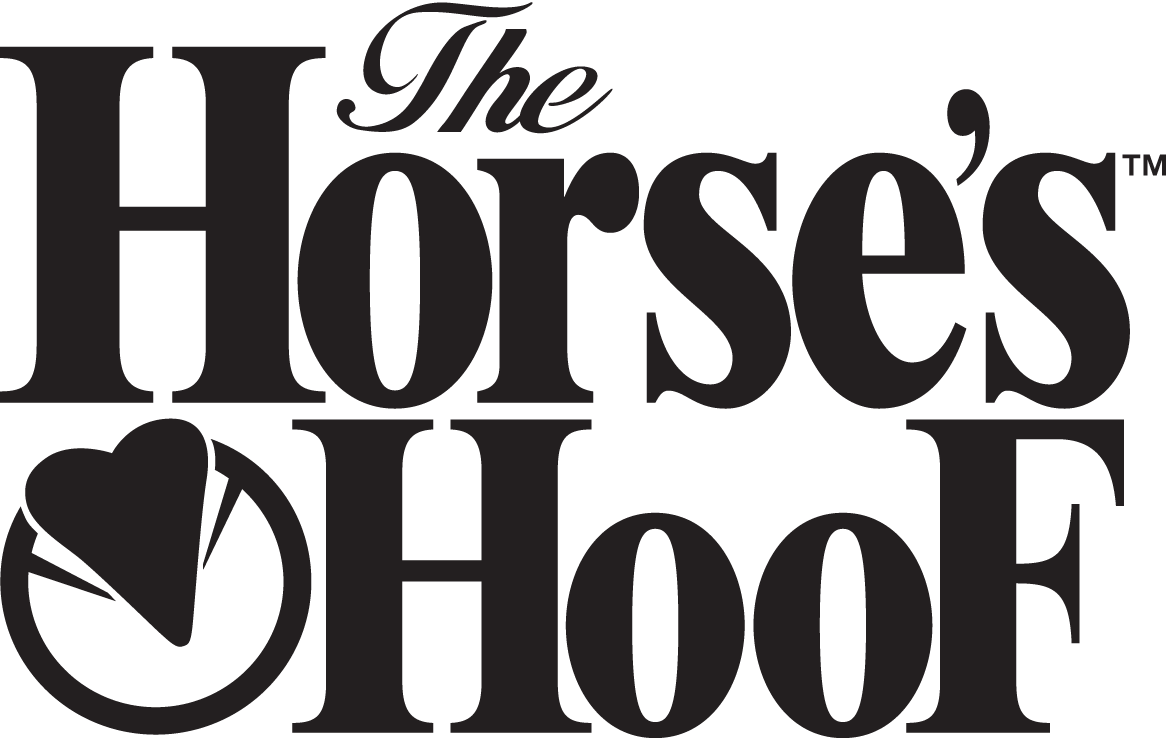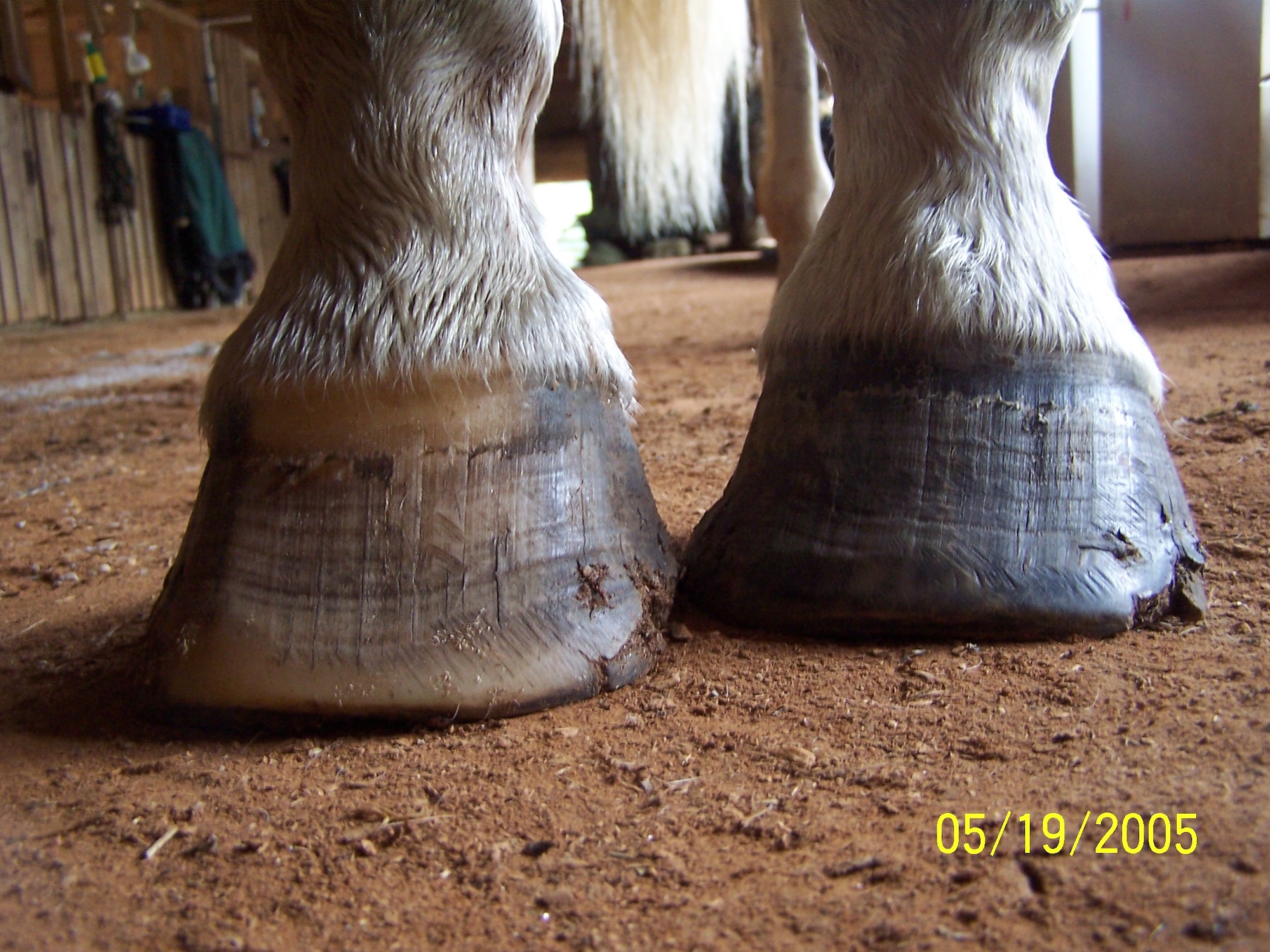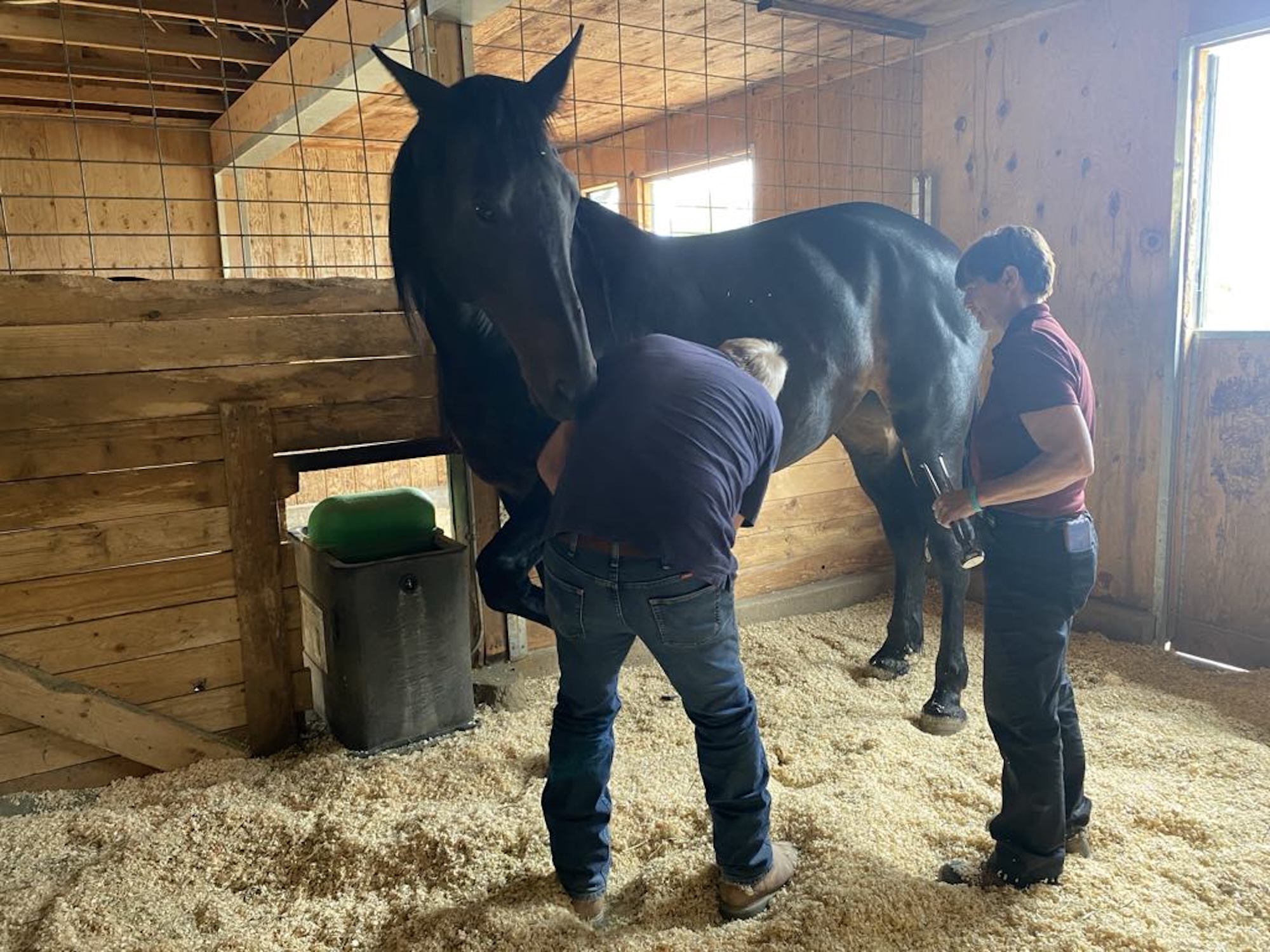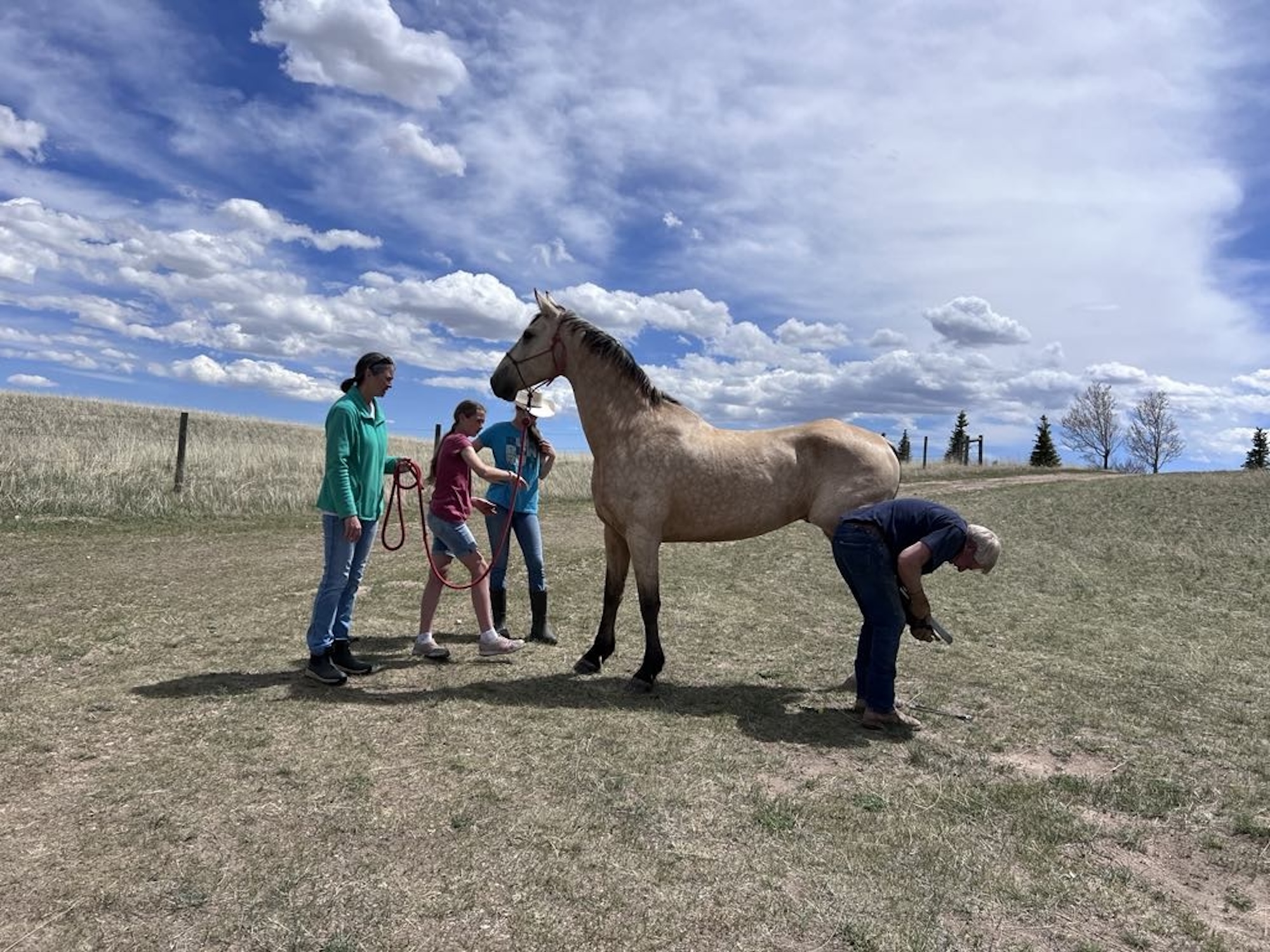One of the problems we have in communicating ideas about the equine hoof is the general lack of standard definitions. When we describe “the healthy hoof,” we have a very specific meaning. This is probably different from what a healthy hoof means to most vets, farriers, horseowners, and even barefoot trimmers. Many people describe a healthy hoof as one which does not suffer from lameness. Unfortunately, since hooves deteriorate slowly over time, this is almost never the case. A healthy hoof is always sound, but a “sound” hoof may indeed be quite unhealthy. It is important to learn to identify health problems early in the hoof, while they are still easily reversible. To learn to do this, you must learn how to identify the healthy hoof.
First, let’s take a look at healthy hoof characteristics as defined by leading experts. Ric Redden, DVM, gives a good traditional description (1): hard, dense walls without chips or cracks; tubules running straight from the coronary band to the ground; toe walls at least 3/8” thick (he notes that the wall then thins at the widest point of the foot and thickens at the turning point of the heel); hooves wider at the ground than at the coronary band; strong, durable bars; a tough, dense, calloused outer sole; and tight white line. We agree with these statements. However, Redden also makes constant allowances for variations in hooves, with different angles of toe and heel, different sizes and shapes of frog, and even heel bulbs that are asymmetrical, with one pushed up higher—all considered acceptable. There are variations in healthy hooves, and some asymmetry is natural, but the standard tolerance for variation in the hoof goes way too far, venturing far into deformity. That’s why horses go lame before a problem is ever realized.
Interestingly, Redden talks about using the “growth rings” to evaluate health (that they should be evenly spaced). He describes that each ring shows 30 days of growth. We observe that readily apparent growth rings are a sign of hoof stress, and should be minimized when you remove the peripheral loading off the walls. Periods of severe wet/dry weather can lead to growth rings, but on a whole, our horses do not have very observable rings, and this is what we strive for.

Only two months have passed between these two photos. The hoof wall was NEVER rasped above the roll. The growth rings, ripples, ridges from before have nearly disappeared, and the wall is smooth. Yet the hoof can only grow a couple centimeters during this time span. How is this possible? We believe that, as Dr. Bowker has described, the hoof wall is fluid. When the outer wall was provided with significant relief from peripheral loading, it was allowed to descend and relax downwards.
Robert Bowker, VMD, PhD, has created his own term of the “good-footed horse” (in contrast to the “bad-footed horse”).(2) His interest is in the internal structures of the hoof, and these terms refer to cadavers studied in his research. He defines the good-footed horse as one which has lived into its 20’s or 30’s with no chronic foot problems. These good-footed horses all shared similar traits:
- thick lateral cartilages (3-4 times thicker than the bad feet)
- well-developed microvessels throughout the hoof
- fibrocartilage in the digital cushion (as opposed to fatty deposits in the bad feet).(3)
He attributes all these features mostly to environmental factors: the horses received adequate movement and stimulation of the hooves, and the hooves adapted by becoming strong. He also comments that he has never seen a good-footed horse that was peripherally-loaded.(3)
Jaime Jackson describes healthy hooves in the context of his study of wild mustang hooves from the Great Basin area of the Western U.S.(4) Front hooves are wider and rounder through the toe than hinds. Hind hooves have steeper toe angles. Toes are very short (average toe length just 3 inches), with concave soles, extremely low heels, passive straight bars, and tough, flat frogs. Interestingly, all observed front hooves were symmetrical, while all hind hooves were a bit asymmetric in the solar view. He also observed that the hoof walls were uniformly thick from toe to heel, with a consistent degree of turn to the mustang roll.
Hiltrud Strasser, DVM, observes that when the horse is in a sound state, the bones of the feet are in alignment, the coffin bone is balanced in a position parallel to the ground, and the coronet forms a line 30 degrees to the ground.(5) She also notes that coffins bones have angles of about 45 degrees for the front hooves, and about 55 degrees for the hind hooves. Heel height is usually about 3 cm from the coronet hairline at the heel to the ground. The bars end halfway down the length of the frog. We agree with all of these points as observations of the healthy hoof, and with an “approximately” always added before every measurement. We do not believe it is productive to trim using measurements, however.
So what constitutes a healthy hoof from our perspective?
- The horse must be sound.
- The hoof form must display certain key elements that all healthy hooves have in common.
- The hoof form must not deteriorate over time, but rather it should improve.
What are the key common elements of healthy hooves?
- Hoof Shape: Wide and relatively round from the solar view. Front hooves are rounder, while hind hooves are a bit more narrow. A typical measurement for a healthy front hoof would be 5 inches wide and 5 1/8 inches long. Hoof proportions on the solar surface should consist of the frog taking up approximately 2/3 total length from heel to apex, with less than 1/3 length in front of the apex to the toe. The hoof capsule is a truncated cone, so the coronet diameter will be smaller than the ground surface diameter.
- Hoof Walls: Healthy walls are flat and smooth, without ripples, ridges or growth rings, and are maintained (by trimming or natural wear) no longer than the live sole. There should be absolutely NO deviation in wall growth between the coronary band and the ground—this should be an absolutely straight line with no flaring or slippering of the toe.
- Coronet: The coronet hairline when viewed from the side is smooth and even, and forms a very gentle arc. (A hairline that is stick straight usually corresponds with a toe that is too long, and stress on the coronet at the toe.) There will be no peaks or deviations to the hairline, including the heel hairline (which is frequently pushed upwards). When viewed from the front, the coronet is straight and level. The healthy hoof will have a full, robust feeling to the coronet band itself, smooth and even all the way around the hoof.
- Heel height: Frogs must be on the ground, therefore healthy heels are always low heels. How low? That’s easy: as low as they need to be for the frogs to be on the ground.
- Heel Bulbs: The wider and flatter the bulbs are (with minimal dip between the bulbs), the healthier the hoof, with a more robust digital cushion. When our customers ask us about purchasing a new horse, our number one recommendation is to look for wide bulbs! Bulbs should also be very symmetrical.
- Heel Platform: Also called heel-bar junction or heel buttress, this is the junction between the outer wall and the bar. In a healthy hoof, this area is large and sturdy, and there is a lot of width between the left and right heel platform on a hoof. The rear of the heel platform will correspond with the widest point of the frog.
- Soles: The overall sole shape is lightly concave and forms a gentle arc which creates a natural relief at the quarters (it is not necessary to trim this into a hoof). Healthy soles are dense and thick. The sole texture should be smooth. There will be absolutely no bar material laying over on top of the sole. The white line should be clean and tight, without separation.
- Bars: The bars are extensions of the hoof wall. Their ideal location in a healthy hoof is pretty simple: they begin at the heel platform, and they end about 1/2 to 2/3 of the way down the frog towards the apex (the bar corium itself ends at this location). Naturally-worn hooves display bars that meet these exact parameters. There are many domestic hooves that are fairly healthy, except for this area of the foot (and there are consequences to that).
- Frogs: Healthy frogs will be wide, flat, with a shallow central sulcus that is more forwards down the frog (towards the apex). Frog texture and width will vary greatly depending upon climate and environment! The wetter the climate, the wider the frog should be. Desert frogs will be tough and leather-like, while wetland frogs will be robust and more rubbery.

This healthy, round front hoof shows the ideal proportions of 2/3 to 1/3.

A healthy hoof has smooth, flat walls without ripples or rings, and with NO change of angle whatsoever from coronet to ground.

How low are the heels? In a healthy hoof, they are simply the natural height which places the frog fully upon the ground.

For heel bulbs, “cleavage” is not desirable! The healthiest heel bulbs are nearly flat and straight across, but you’ll usually only find those on never-shod horses that have always been well-trimmed.

The arch in the quarters is already there in the sole shape of the healthy hoof.

Healthy bars are well-defined and end about halfway (up to 2/3) down the frog towards the apex.

A healthy frog has a shallow central sulcus that is more forwards (i.e., towards the apex).
All of these key features can be readily observed in healthy hooves, no matter what their breed or environment. Health most certainly comes in degrees: a hoof might be quite healthy, and still have many problems that need to be addressed. Keep in mind, there is no perfect hoof, and even if you find such an ideal specimen, like all living things, it is in a constant state of change—for better or for worse.
- “Healthy Hooves, Inside and Out” The Horse Magazine, By Ric Redden, DVM, with Christy West.
- “Contrasting Structural Morphologies of ‘Good’ and ‘Bad’ Footed Horses” by Robert M. Bowker VMD, PhD.
- Robert M Bowker, VMD, PhD, seminar “The Equine Foot for the 21st Century,” January 23-24, 2007.
- “The Natural Horse” by Jaime Jackson.
- “The Hoofcare Specialist’s Handbook: Hoof Orthopedics and Holistic Lameness Rehabilitation” by Hiltrud Strasser, DVM & Sabine Kells.
by James and Yvonne Welz, published 2011 Hoof Help Online & The Horse’s Hoof Magazine, Issue 48, Fall 2012
See the full content listing of all issues of The Horse’s Hoof Magazine! We also provide instructions on how to read the issues for free on Hoof Help Online.
For a detailed listing of all articles on The Horse’s Hoof website, please visit our Article Directory.




